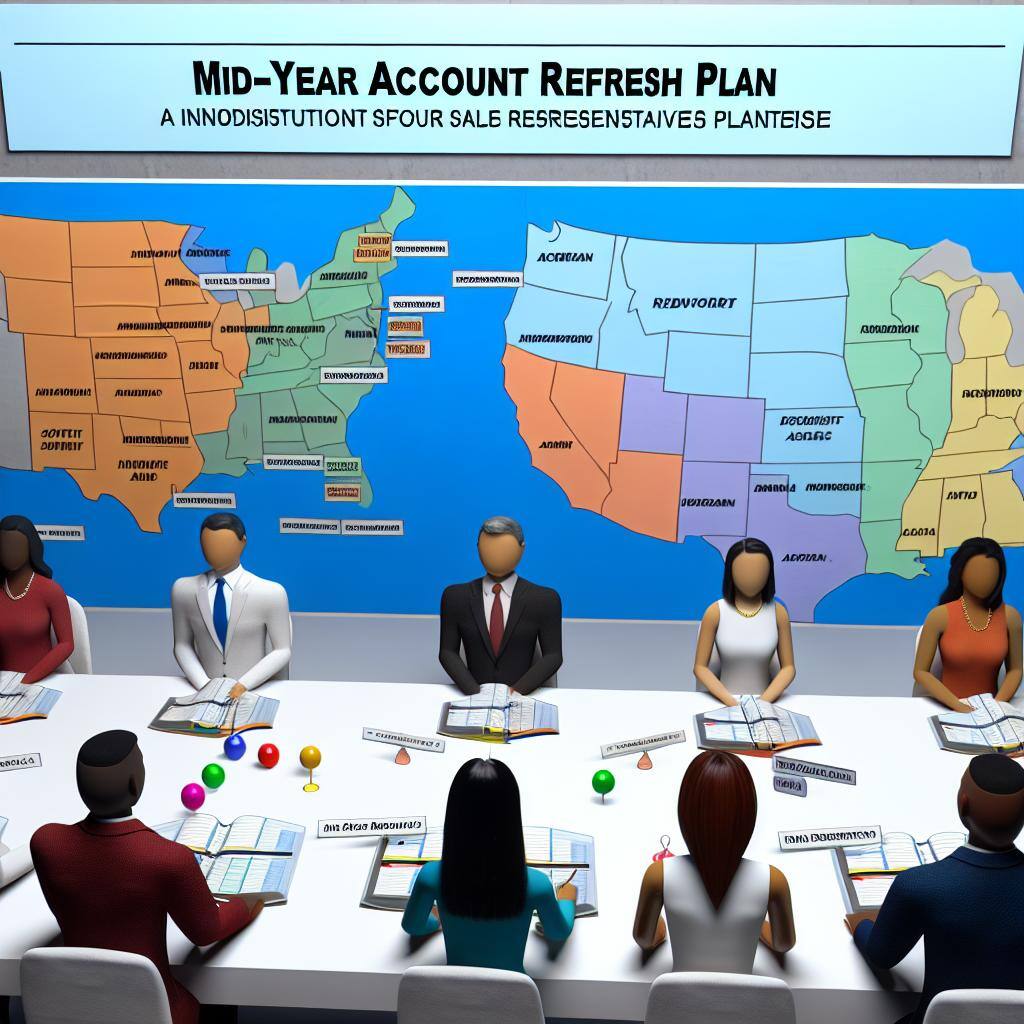COVID-19 has turned all sales into inside sales. After all, what is field sales when all the trade shows are canceled and your reps can’t leave their house to visit a customer? As in many other areas of our lives, COVID has accelerated a trend in sales that was already underway: the death of geographic sales territories.
One of the most surprising things for me since starting Gradient Works is how alive geographic territories are, especially given my own experience at companies that had long since done away with them (for reasons I’ll explain below). Over the past few months, I’ve done more than 50 customer development interviews with revenue and operations leaders from B2B companies of all sizes, and one clear theme has emerged: the majority still use some form of geographic sales territories even though most either a) wish they didn’t, or b) are actively transitioning away from them.
So let’s dive in and see why geographic territories have outlived their usefulness, what a superior replacement looks like, and where we go from here.
What's wrong with geographic sales territory segmentation anyway?
The first job of any segmentation model is to maximize opportunity for the business. The second job is to balance equality of opportunity for reps. Geographic territories do neither.
Let’s start with balancing rep opportunity. Opportunity is certainly not equally distributed geographically. The 94105 zip code in SOMA in the heart of San Francisco is home to hundreds of the fastest growing companies in the world whereas 79831, near Alpine, Texas is 348 square miles with a population of 29 people. The first challenge then with any geographic territory model is to try to aggregate plots of land (usually identified by zip codes) into territories in a way that at least starts to balance the opportunity. The enormous disparities involved generally mean this can’t be reasonably achieved.
Since we can’t practically build geographic territories that have the same potential value, we resort to using comp plans to balance out opportunity. This usually comes in two forms: giving less senior reps the lower OTE that comes with less valuable territories and/or altering comp plans in the worse territories. This creates tremendous overhead, not just in comp plan administration, but also in how you build the career path for your reps. If the only way for a rep to achieve a higher OTE is to move to a richer territory, and that territory is already owned by someone else, then they’re stuck - and likely looking for a new job.
So, do geographic territories at least maximize opportunity for the company as a whole? Sadly, no. The way to maximize opportunity for the company is to maximize your overall throughput, i.e. the rate at which you turn potential customers into dollars of revenue. There are a lot of levers here (price changes, sales cycle changes, etc) but in the end, your upper bound is going to be based on the aggregate throughput of all your reps. Geographies reduce the throughput of some reps so geographic territories artificially lower your throughput.
An analogy helps make this clear. Say you’re shopping for groceries and you go to the checkout. Most of the time you pick a particular checkout line and wait your turn. There’s only one person at the register in each line so if there’s a holdup, your line could wait much longer than the others. How many of you have stood there watching all the other lines move faster because someone in front of you is counting out change?
That’s annoying of course, but at least we can pick the line we think we’ll get through the fastest (no senior citizens with full carts clutching their checkbooks). Now, imagine if the grocery store forced you into a particular checkout line based on the neighborhood you live in. If it turns out a lot of people in the store are from the same neighborhood, your cashier is going to pretty quickly get overwhelmed even as the cashiers serving other neighborhoods are sitting around looking at their phones. You, the customer, have a less-than-stellar experience and might decide to skip your purchase or buy the same thing somewhere else. The grocery store, meanwhile, is paying some cashiers to do nothing while others aren’t able to actually process all the business coming their way.
You can poke at the analogy (e.g. sales reps can handle more than one customer at once, the “idle” reps could be out prospecting), but the end result is that pre-allocating your prospects to specific reps means your overall throughput is limited by the maximum throughput of your busiest reps. You can further subdivide your territories and hire more reps but you’re essentially just squeezing the balloon instead of solving the underlying problem: a misallocation of opportunity that can’t adapt to changing demand.
There is, however, a better way to do it. Organize all the customers into a single line that feeds into a group (or “pool”) of cashiers. As a cashier becomes available, the next person in line steps up and goes to that cashier. If that transaction takes a while, the next person in line just goes to the next free cashier. The overall throughput of the system is no longer bounded by the slowest cashier, but by the fastest. It also helps ensure that, on average, each cashier stays equally busy so if you’re the grocery store, you’re getting the most work from your employees.
This kind of “pool” is a much more efficient way to process anything: whether it’s web site visitors, grocery shoppers, or B2B SaaS customers. In a sales context, allocating a pool of prospects to a pool of reps ensures that, over time, you’re both maximizing throughput and equalizing opportunity per rep. If every rep has equivalent opportunity this means your comp plans and your rep career progression both become simpler.
The good news is that many sales teams already do a variation of this approach using some form of round-robin assignment within their processes. The bad news is it’s often limited to a small part of the business (e.g. lead routing to BDRs) while the rest of the org uses more antiquated approaches.
So how do you expand this approach into the rest of the org?
First, we need to realize that “local knowledge” about a particular territory (or vertical) doesn’t matter as much as we like to think. There are times when it does: large cultural differences (e.g. US business norms differ from Japanese), when selling deeply verticalized solutions (e.g. security compliance requirements differ for Financial Services firms vs Government) or complex strategic sales (e.g. ERP or CRM). However, most businesses selling B2B subscriptions exist because they’re solving a problem for a function that’s found at a large number of businesses. In fact, a large TAM is what makes these businesses so appealing in the first place.
The only knowledge that really matters for most modern B2B businesses is domain expertise. As long as reps are educated on their solution and talking to the right buyer persona, it doesn’t matter where the prospect is from.
Second, we need a way to quantify opportunity. Remember the first job of any segmentation model is to maximize opportunity - and if you can’t measure it, you can’t manage it (thanks Peter Drucker). Some prospects are more qualified and more ready to buy than others. None of this has anything to do with where the prospect is located. It has everything to do with the value the prospect represents.
Quantifying opportunity should take the form of a metric that describes potential value for a given prospect or customer. This can be anything from a qualitative fit with an ideal customer profile, to a key set of metrics you believe relate to potential (e.g. employee count, annual revenue), to a sophisticated propensity-to-buy scoring model based on feeding the latest machine learning systems reams of data. While it can be incredibly complicated, it doesn’t have to be. It just needs to be reasonably correlated with value.
Finally, we need to change the way we think about what reps “own’. Specifically we need to move from the idea of fixed territories to dynamic books. Instead of laying out ahead of time which accounts a rep will own based on a geographic region, reps have a group of accounts they’re actively working that changes over time - aka their book. Given that you have a metric to measure potential opportunity, you can now keep these books balanced based on the total potential value of the book, the rep’s ability to realize value and the rep’s capacity to manage the demands of their book.
For example, your most senior reps with the highest quota might have smaller books that have a higher average value and your more junior reps might have larger books with lower average value. You also might have capacity measures, such that a rep who isn’t actively working their book might be assumed to be “at capacity” and so wouldn’t be eligible for new opportunities until they demonstrate they have available capacity. There are many ways to build dynamic books; it’s a big topic that deserves its own post (and will get one soon).
When you combine all these elements, you’ve got a model to replace geographic territories. By focusing on domain expertise, quantifying opportunity and dynamically assigning books, you get the ability to ensure that all your reps are operating at maximum capacity which raises the throughput of your entire organization. Furthermore, you can demonstrate to reps that they have equal opportunities to succeed because their books are equivalent in value. In short, this fulfills both criteria of a successful segmentation model.
Why do geographic territories persist despite all these drawbacks and the availability of better alternatives?
There’s certainly an element of inertia. Geographic sales territories are an artifact of an earlier time where, in order to sell to someone, you had to be physically co-located near them. In short, all sales motions were field sales motions. There really was no other option but to divide things up by geography and place reps in each one. As we’ve moved into an age of inside sales, software delivered over the internet, and Zoom meetings, the received wisdom about how to organize teams just hasn’t caught up.
There’s a bigger reason though: psychology. I had a recent conversation with a revenue leader at a unicorn-tier company with more than 600 employees that talked about rep psychology as the main reason for being unable to move away from a geographic model. Sales reps want to “own” their patch (of land) because they feel like it maximizes their opportunity even if the math clearly states that it doesn’t. There’s also a very human need to “defend our territory”. If we have a clearly defined plot, we can tell other people to stay off it and therefore not suffer any risk that someone else might get a deal we believe we “deserve”.
Those are some powerful forces standing in the way of change. We have to change, though. Sales models built for a pre-internet - much less a pre-COVID - era are failing us. B2B companies (especially SaaS) are seeing an explosion in CAC due to large, inefficient sales teams that aren’t constructed to maximize their throughput. This is especially dangerous for scaling companies as payback periods get longer and the cash trough required to hit growth targets gets deeper. Even scaled companies are routinely spending 50% of their top line revenue on sales and marketing. This is unsustainable.
Luckily there’s a better model there that aligns your expensive sales resources with the potential value of your pipeline while ensuring reps maximize their own opportunity for success. Let’s drive the next decade of post-COVID growth by ditching geographic sales territories once and for all. Everybody into the pool.




